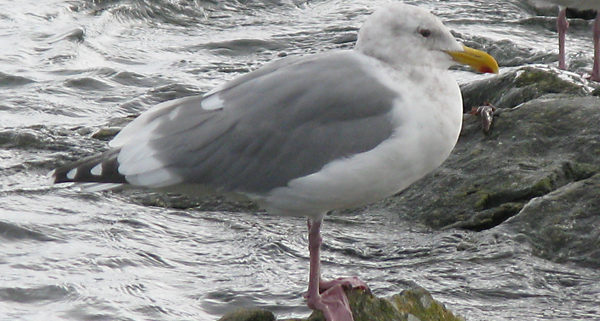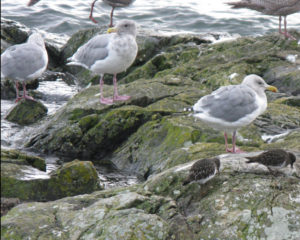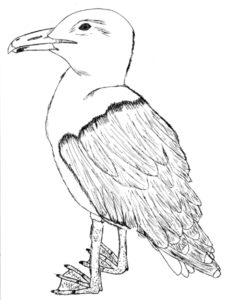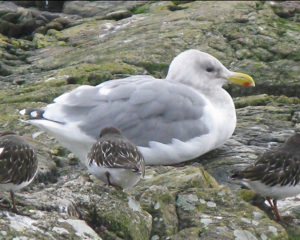Glaucous-winged Gull By Zach Cameron Scientific name: Larus glaucescens Size range: Length: 19.7-23.2 in (50-59 cm) from head to tail Wingspan: 47.2-56.3 in (120-143) Weight: 31.7-42.3 oz (900-1200g) Identifying Features The Glaucous-winged Gull is a sizable bird of the Laridae (gull) family, growing to around half a meter in length with a meter and a half wingspan. It can be identified by its web-footed pink legs and a red circle on its large yellow beak as well as its distinctively grey wings and back feathers. The gull has a white tail and chest. The undersides of its wings are also white and it has hints of grey throughout. Males can be distinguished from females by their larger size. Younger gulls are a more grey-brown all over with a black beak and a dark ring around their eyes. With breeding plumage, the feathers around the gull’s head are completely white and a pink circle is directly around both of their eyes. The Glaucous-winged Gull’s non-breeding plumage differs only by the fact that the head feathers are speckled in a grey to brown colouring and lack the ring around the eye. Interbreeding between gull species can make it a challenge to identify them but they can be quickly distinguished by their solely grey and white plumage. Habitat Being a coastal sea bird, the Glaucous-winged Gull is usually found close to salt water and a food source. It can be found as far north as the Bering Sea, down to the Pacific coast going through Alaska, British Columbia and into northwestern Washington. During the winter they are commonly found in Asia going down to Japan. They often habitat beaches and rocky shorelines but also go up rivers in search of spawning salmon. These birds have integrated themselves well into man made environments, living around cities, harbours, garbage dumps and following fishing boats out into open waters. They have become especially successful because of garbage dumps; due to the dumps being such a great food source, there has been large increase in the gull population. Food Glaucous-winged Gulls are omnivores that will eat just about anything. They are both scavengers and predators that can be found eating garbage and carrion (decaying flesh), stealing from other sea birds such as cormorants and pelicans, and feeding on salmon in the interior and marine animals in the open ocean. These gulls have a very wide diet that includes garbage, fish, seaweeds, mollusks, barnacles, other birds, small mammals, sea urchins and other invertebrates, crustaceans and so on. Being a bird, it uses its flight and speed to capture its prey as well as its large beak as an offensive tool. The birds will also use rocks to break open the harder, protected prey, by dropping the prey from a high height onto the rocks. Predators Adult Glaucous-winged Gulls do not have much in terms of predators. Bald eagles are known to eat the gulls throughout their lifetime as well as skuas, crows, and ravens who will steal gull eggs. The Glaucous-winged gull itself is a large predator of the species which often resorts to cannibalism of the younger and smaller chicks and eggs. Life Cycle Glaucous-winged Gulls usually live to around 10 years old but have been known to live almost three times as long. They reach breeding age and adult plumage at 4 years old and will go to the same place and keep the same mate for most or all of their lives. They usually nest between April and August and lay 1 to 5 eggs. Their nests are made up of whatever they can gather in the area, using anything from seaweeds, plants, driftwood and even garbage. They nest on top of buildings, on beaches, in trees, islands, and cliff faces. Chicks will hatch around 27 days after the eggs are first laid and can usually fly at 44 days old. Glaucous-winged Gulls regularly breed with other species of gull (such as the Herring and California Gulls) when their territories cross. Illustration by Zach Cameron, Photograph by Lydia Young
References Bullard, T. (2001) Larus glaucescens. Animal Diversity Web. Retrieved May 15, 2011 from http://animaldiversity.ummz.umich.edu/site/accounts/information/Larus_gl…. Cambell, W. Dawe, N. K. McTaggart-Cowan, I. Cooper, J. M. Kaiser, G. W. McNall, M. C. E. (1990) The Birds of British Columbia: volume two, nonpasserines diurnal birds of prey through woodpeckers. Victoria, British Columbia: The Royal British Columbia Museum. Cannings, R. Aversa, T. Opperman, H. (2005) Birds of Southwestern British Columbia. Surrey, British Columbia: Heritage House Publishing Company LTD. Cornell University. (2011) Glaucous-winged Gull. The Cornell Lab of Ornithology. Retrieved May 15, 2011 from http://www.allaboutbirds.org/guide/Glaucous-winged_Gull/lifehistory. Patten, S. (1998) Gulls. Alaska Department of Fish and Game. Retrieved May 20, 2011 from http://www.adfg.alaska.gov/static/education/wns/gulls.pdf. Seattle Aubudon Society. (2005) Glaucous-winged Gull. Seattle Aubudon Society.org. Retrieved May 15, 2011 from http://www.seattleaudubon.org/birdweb/bird_details.aspx?id=206.
Interesting resources for research and photographer credit
Latest Projects
VicHigh Marine
Victoria High School
1260 Grant St.
Victoria. BC, Canada
V8T 1C2
Phone: 250-388-5456
Email: dsyoung@sd61.bc.ca








Leave a Reply
Want to join the discussion?Feel free to contribute!